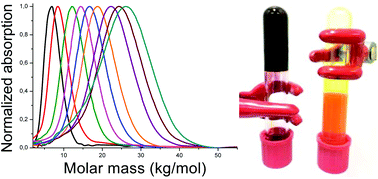The influence of branching on the Kumada catalyst transfer condensative polymerization of 3-alkylthiophenes†
Abstract
To study the influence of branching of the side chain on the Kumada catalyst transfer condensative polymerization (KCTCP) of 3-alkylthiophenes, first, a new, severely branched precursor monomer, 2-bromo-5-iodo-3-(2-octyldodecyl)thiophene, was designed. The controlled character of its polymerization was investigated and rate studies for both poly(3-hexylthiophene) (P3HT) and poly(3-(2-octyldodecyl)thiophene) (P3ODT) were performed. Second, the influence of non-covalent gelation on the controlled character of the polymerization was studied through the determination of the maximal degree of polymerization that could be obtained in a controlled manner. Third, nona-stage polymers were synthesized and the lifetime of the active chain ends for P3HT and P3ODT was studied. Last, the nature of the occurring termination reactions was established. Altogether, these results point out the difference in polymerization behavior between branched and linear alkyl substituents and, related to this, between gelated and non-gelated polymerization mixtures.



 Please wait while we load your content...
Please wait while we load your content...